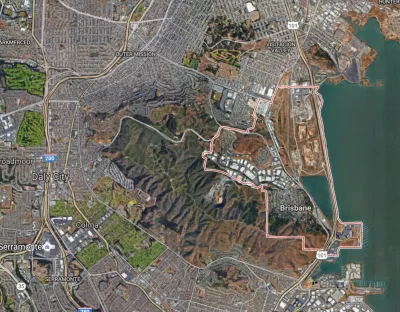Penny is an artificial intelligence program that detects affluence from space. It also lets users experiment with how different visual forms affect its perception of an area's wealth.

The patterns of urban wealth and poverty, apparently, are obvious enough for an AI to discern. Laura Bliss writes, "A joint collaboration between Stamen Design, DigitalGlobe, and Carnegie Mellon University, Penny is artificial intelligence that can 'read' satellite imagery of two very different cities and judge the income brackets of neighborhoods within them."
Focusing on New York and St. Louis, the program judges wealth from visual patterns alone, not from "knowing" how any building or feature is used. "The tool is meant to provoke conversation around a conclusion with scientific backing: Wealth is visible from space—and can be tracked as its contours invariably shift."
In the future, could AI help planners make better decisions? Or is it too inhuman an instrument? "Already, artificial intelligence is being used to help govern cities in certain contexts, such as predicting where traffic and crime might occur. How far into urban space should AI tread?"
FULL STORY: A Mapping Machine Identifies Wealth From Space

National Parks Layoffs Will Cause Communities to Lose Billions
Thousands of essential park workers were laid off this week, just before the busy spring break season.

Retro-silient?: America’s First “Eco-burb,” The Woodlands Turns 50
A master-planned community north of Houston offers lessons on green infrastructure and resilient design, but falls short of its founder’s lofty affordability and walkability goals.

Delivering for America Plan Will Downgrade Mail Service in at Least 49.5 Percent of Zip Codes
Republican and Democrat lawmakers criticize the plan for its disproportionate negative impact on rural communities.

Test News Post 1
This is a summary

Test News Headline 46
Test for the image on the front page.

Balancing Bombs and Butterflies: How the National Guard Protects a Rare Species
The National Guard at Fort Indiantown Gap uses GIS technology and land management strategies to balance military training with conservation efforts, ensuring the survival of the rare eastern regal fritillary butterfly.
Urban Design for Planners 1: Software Tools
This six-course series explores essential urban design concepts using open source software and equips planners with the tools they need to participate fully in the urban design process.
Planning for Universal Design
Learn the tools for implementing Universal Design in planning regulations.
EMC Planning Group, Inc.
Planetizen
Planetizen
Mpact (formerly Rail~Volution)
Great Falls Development Authority, Inc.
HUDs Office of Policy Development and Research
NYU Wagner Graduate School of Public Service





























